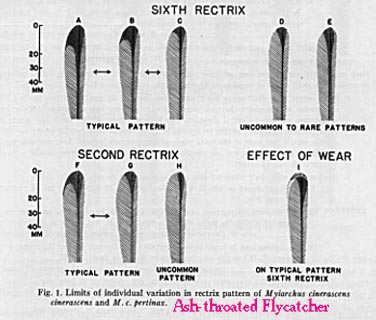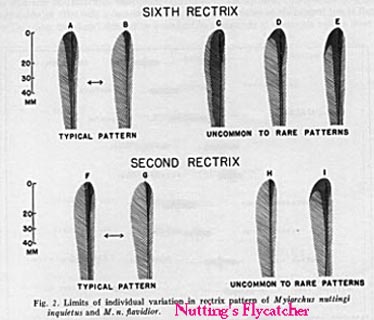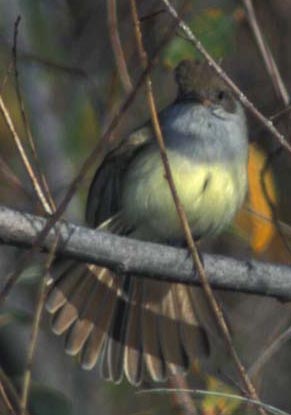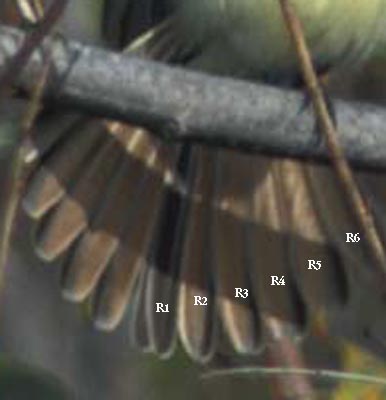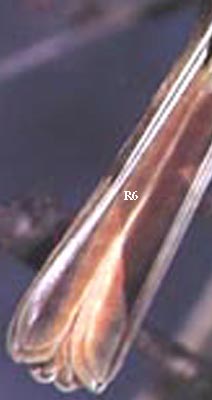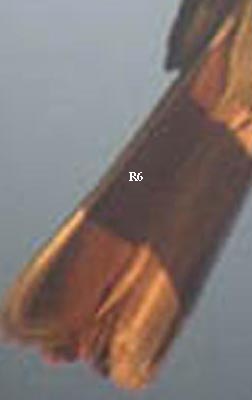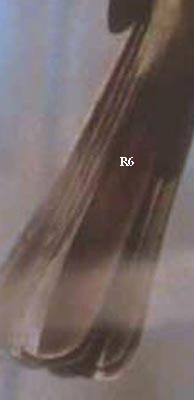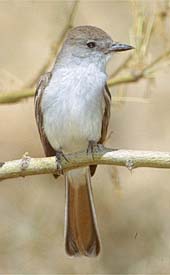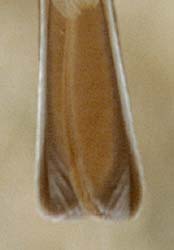A PHOTO DISCUSSION ON NUTTING'S
FLYCATCHER IDENTIFICATION:
Part 4: TAIL PATTERN
text © 2003 Don Roberson
all photographs are copyrighted © 2003
by the photographers cited; used here with permission
| Lanyon (1961) created a key for separating specimens of Ash-throated
and Nutting's Flycatchers, and accompanied that key with two illustrations
showing variation in both species. There is remarkable variation is tail
pattern. Standard field guides (e.g., National Geographic 1999, Howell
& Webb 1995) can only show the most typical patterns. The most important
feather is the outermost rectrix, numbered "R6" in banding shorthand (there
are six sets of feathers in a flycatcher's tail, thus 12 in all, numbered
from the center because the molt is from the center and outward). The shaft
of the tail feather separates the tail into two parts: the narrow outer
web and the broader inner web. It is the pattern on the inner web that
is important.
On most Ash-throated Flycatchers, the inner web is entirely rufous (right
up to the shaft) until, near the tip of the feather, the brown outer web
suddenly expands and "cuts off" the rufous before it reaches the tail tip.
One typical pattern to shown on this fine photograph © Peter LaTourrette,
taken at Jasper Ridge near Stanford Univ., California, in April 1993 (many
beautiful shots at Jasper Ridge are on Peter's Jasper
Ridge web site). |
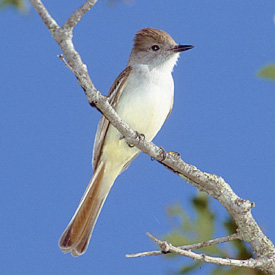 |
| Another common Ash-throated pattern is for this brown color (called
"fuscous" by Lanyon) to "hook back" along the inner edge of the inner web,
nicely shown (right) on another Peter LaTourrette photo, this one from
Stevens Creek park in Santa Clara Co. (yet another wonderful set of photos
are on Peter's North American Bird
Gallery).
As we shall see further down this page, the "typical" Nutting's Flycatcher
tail does not have the brown outer web rapidly expanded at the tip, "cutting
off" the rufous from the tip. Instead, there is a brownish shaft streak,
typically including a tiny bit of the inner web next to the shaft, that
gradually expands towards the tip. The brown area usually broadens at the
tip, but some of the rufous on the inner web is "free" to continue right
to the tip of tail. [On both species the thin outer web is mostly brown
but in fresh plumage there can be a whitish edge around the entire feather.] |
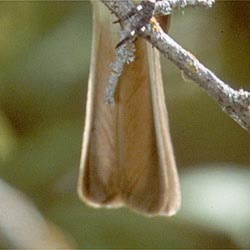 |
The larger Brown-crested Flycatcher M. tyrannulus apparently has
little variation in its tail pattern: a simple shaft streak covering both
sides of the shaft, but not expanding at the tip (Cardiff & Dittmann
2000). This pattern is shown in the standard field guides (e.g., Howell
& Webb 1995, Nat'l Geographic 1999). In discussing how Brown-crested
differs from other Myiarchus, Cardiff & Dittmann (2000) explain
that Nutting's is particularly variable in tail pattern, running the gamut
from "typical" Brown-crested pattern to (rarely) typical Ash-throated patterns.
Reproduced below is Lanyon's (1961) figures on tail variation in Ash-throated
(figure 1) and Nutting's (figure 2) flycatchers. Note the "typical" patterns
of both species come in at least three variations, and then there are "rare"
patterns that closely match the pattern of the other species. Lanyon's
key shows R6 (the sixth rectrix) on the top row. He also illustrates R2
(the second rectrix) but that is only important when one gets into the
"rare" patterns shown by a small minority of birds.
Larry Sansone took the lovely spread-tail shot below of the Orange County,
s. California, Nutting's Flycatcher. This or a very similar photo was published
at West. Birds 33:193 in the CBRC report that accepted this record.
Alas, when we enlarge the tail and number the rectrices, the key feather
— R6 — is half-hidden by branches on both sides in this particular shot.
I have found photos of the Arizona bird, however, that show R6 reasonably
well. In the set of three shots below, two of them are of the Arizona bird
but by different photographers (Larry Sansone, Ed Harper). Can you pick
up the two that are of that Arizona Nutting's? I will tell you that brightness/contrast
and hue saturation has been adjusted on one of the shots (but not the others)
in an attempt to show the pattern as best as could be done. I am attempting
to show R6 on the left hand side, although Lanyon (1961) says his key works
with either side and birds are essentially symmetrical in their patterns.
That left-hand outer rectrix is labeled "R6." When the tail is folded,
this is the bottom feather seen from below.
Can you find the two identical tails in this group? I think it is fairly
hard to do because of the differences in lighting , film and reproduction,
but the two identical ones are the left-hand and the right-hand birds;
only the right-hand bird has been retouched to try to bring out contrast
a bit. Note that on all three the rufous inner web extends to the tip at
the inside "corner" of the tail tip and for a bit further along the tip.
If anything, the center bird seems to have slightly more rufous at the
tip. Also, the brown expansion seems a tiny bit more gradual on the Arizona
bird (left and right) than the center bird. But on all three you can see
that the brown color extends as a thin stripe across the shaft and into
the inner web at the mid-point of the tail, about where the words "R6"
appear. Tails in this group of Myiarchus run in the 75-95mm range
(Lanyon 1961, Pyle 1997) but (of course) some portion is hidden by tail
covert feathers where inserted. It is fair to say that the 30-35mm point
from the tip is about or just a bit short of the halfway point on the tails.
This is the point marked by the double-headed arrows on Lanyon's key (above),
and hopefully approximated by the "R6" words on each photo in this set.
Obviously, the 20mm point (from the tip) would be about a third closer
to the tip. Beyond the pattern of the tail tip, Lanyon explained that the
typical Nutting's had a thin but obvious (greater than half-a-millimeter)
shaft streak at the 20mm point where the brown encroached into the rufous
inner web.
Look for yourself, but I see that there is brown on the inner web, to
the right of the feather shaft, at a point a third of the way closer to
the tip than the "R6" printing. Indeed, there is still a tiny sliver of
brown on the inner web right next to the shaft at the "R6" lettering (or
approximately the 30mm mark).
You can see that all these feathers are fresh; none have ragged or worn
tips. Therefore the top row of Lanyon's key applies. You can judge for
yourself, the patterns shown by these birds (recognizing that the left
and right photos are the same bird) seems to generally match "A" in the
Nutting's chart (a typical pattern for Nutting's) or, possibly, pattern
"E" in the Ash-throated chart (a rare pattern).
The middle photo (above) is the Santa Cruz bird. It is Tom Grey's photo,
with tail enlarged, but I have flipped the image to compare it with the
other two. It is actually the right-hand R6 (when viewed from below) rather
than the left-hand feather. However, Lanyon (1961) says "presence of a
character or condition on either the left or right rectrix is acceptable
in the use of the key" so comparing a left-hand feather of one bird to
the right-hand equivalent feather of the other should not matter. [Again,
I repeat that the two left photos above are unadjusted in PhotoShop in
any way, except to enlarge the scans.]
| However, it is not this simple. Look at the photo immediately to the
right, and especially that triangular area outlined in white on the next
inset. I see this area as a dull fuscous, and when I first viewed the tail
immediately to the right, I thought it was an obvious Ash-throated because
the brown covered the entire tip. |
  |
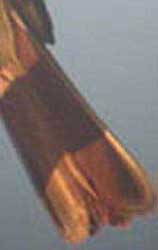 |
| I was quite wrong. The tails on the top row just above are all of the
Santa Cruz bird, taken at about the same time but with different equipment.
Tom Grey's tail (far right, but now reversed to its original orientation)
was digiscoped with an Olympus digital camera and a Nikon Fieldscope, and
has no flash. Peter LaTourrette's tail (above left) was taken on film with
fill-flash. |
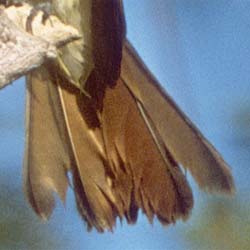
|
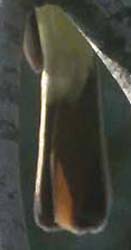 |
And, to further complicate things, the bird had just taken a bath. See
Peter LaTourrette's photo (just above) of the wet tail — see how ragged
it looks before it is dried and preened into shape. My own photo of the
undertail (just above and far right) is backlit and shows extensive rufous
to the inner web extending right to the tip. But I am not convinced we
are seeing the pattern of R6 in my shot. The inner rectrices — R5 in to
R2 — have much more rufous on the inner web in each species. If you go
back to the photos at the top of this page, you can see how much rufous
there was on the inner web of these feathers in the southern California
Nutting's. You can see R5 reasonably well even on the wet tail in LaTourrette's
photo just above, and it has lots of rufous. If my photo is a composite
of R5 and R6, we can't say for sure what the pattern of R6 is in these
photos. [We can, however, use field descriptions. Those I have examined,
including my own, describe an R6 that has rufous running to the tip, not
"cut-off" as in the typical Ash-throated pattern. Thus it would be reasonable
to conclude that Tom Grey's digiscoped shot better illustrates the actual
pattern than the fill-flash photo by LaTourrette, at least in this specific
feature in the early morning lighting present. Fill-flash may have 'created'
shadows or color variation where none were present.]
Important Note: These uncertainties about
tail pattern illustrate yet again that (a) making subtle color judgments
on the basis of one photograph is unwise and (b) differing photographic
techniques can yield different results, even if taken contemporaneously.
We also must not overlook the fact that both species (Ash-throated and
Nutting's) show extensive variation in tail patterns. Below are some other
nice LaTourrette photos of Ash-throated Flycatchers in California. The
left hand bird is from Morongo Valley (where Brown-crested also nests)
and the center shot is an enlargement of that tail. Below right is the
same Santa Clara Co. tail shown near the top of this page. These are just
some of the variations present in Ash-throated Flycatcher.
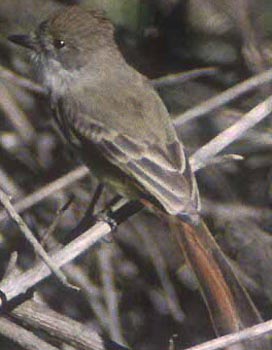
Nutting's Flycatcher, if anything, is even more variable; see Lanyon's
chart above. There are various video-caps
of the southern California bird that show it had more brown at and
near the tip of the tail than did either the Arizona Nutting's or the Santa
Cruz bird. My own photograph of that Orange County bird (right) shows extensive
dark well into the inner web. [In this unusual shot, R6 is disarranged
and sitting unnaturally on the top of the tail, instead of folding below.
We thus see the top of the outermost rectrix on the left side. Tail patterns
are the same above and below, although the colors may be somewhat more
intense from above.]
Given this range of variation, one might opine that the tail pattern
of the Santa Cruz bird could fit either species. You can determine for
yourself whether it better fits a "typical" pattern of one or the other
species, but it may be unwise to assert that the tail pattern conclusively
identifies the Santa Cruz bird.
I am particularly grateful to Peter LaTourrette for the photos and points
discussed on this page. He says that he has long been skeptical of tail
pattern as a very useful character in the field on this group, and the
evidence seems to support his comment. The other pages in this project
are:
LITERATURE CITED:
-
Bowers, R.K., Jr., and J.B. Dunning, Jr. 1987. Nutting's Flycatcher (Myiarchus
nuttingi) from Arizona. Amer. Birds 41:5-10.
-
Cardiff, S.W., and D.L. Dittmann. 2000. Brown-crested Flycatcher (Myiarchus
tyrannulus) in The Birds of North America, No. 496 (A. Poole
and F. Gill, eds.). The Birds of North America, Inc., Philadelphia, PA.
-
Cardiff, S.W., and D.L. Dittmann. 2002. Ash-throated Flycatcher (Myiarchus
cinerascens) in The Birds of North America, No. 664 (A. Poole
and F. Gill, eds.). The Birds of North America, Inc., Philadelphia, PA.
-
Devillers, P. 1971. The alleged occurrence of Nutting's Flycatcher in Baja
California. Calif. Birds 2:140.
-
Dickerman, R.W., and A.R. Phillips. 1953. First United States record of
Myiarchus nuttingi. Condor 55:101-102.
-
Dittmann, D.L., and S.W. Cardiff. 2000. Let's take another look: Myiarchus
flycatchers. LOS News 193:3-10. Louisiana Ornithol. Society, Baton Rouge.
-
Howell, S.N.G., and S. Webb. 1994. Field identification of Myiarchus
flycatchers in Mexico. Cotinga 2:20-25.
-
Howell, S.N.G., and S. Webb. 1995. A Guide to the Birds of Mexico and northern
Central America. Oxford Univ. Press, New York.
-
Lanyon, W.E. 1961. Specific limits and distribution of Ash-throated and
Nutting flycatchers. Condor 63:421-449.
-
Lanyon, W.E. 1997. Great Crested Flycatcher (Myiarchus crinitus)
in
The Birds of North America, No. 300 (A. Poole and F. Gill, eds.). The Birds
of North America, Inc., Philadelphia, PA.
-
Murphy, W.L. 1982. The Ash-throated Flycatcher in the East: an overview.
Amer. Birds 36:241-247.
-
National Geographic Society. 1999. Field Guide to the Birds of North America,
3rd ed. Nat. Geogr. Soc., Washington, D.C.
-
Phillips, A.R., and W.E. Lanyon. 1970. Additional notes on the flycatchers
of eastern North America. Bird-Banding 41:190-197.
-
Pyle, P. 1997. Identification Guide to North American Birds, Part I: Columbidae
to Ploceidae. Slate Creek Press, Bolinas, CA.
-
Zimmerman, D.A. 1978. A probable Nutting's Flycatcher in southwestern New
Mexico. West. Birds 9:135-136.
TOP
GO TO MONTEREY
COUNTY PAGE
GO TO HOME PAGE
GO TO
IDENTIFICATION PAGE
GO TO BIRDING THE
WORLD PAGE
GO TO BIRD FAMILIES
OF THE WORLD
Page created 25-28 Jan 2003


